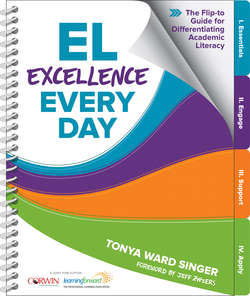Читать книгу EL Excellence Every Day - Tonya Ward Singer - Страница 5
На сайте Литреса книга снята с продажи.
Contents
Оглавление1 Foreword
2 Acknowledgments
3 About the Author
4 Section I: Essentials for EL Excellence1. IntroductionWhy This Book?Helping Every Teacher Excel Teaching ELsCore Pedagogy for EL ExcellenceHow This Guide Helps You Every DayWays to Use This Flip-To Guide2. Essential MindsetsMindsets MatterValue English Learners’ AssetsExpect Excellence From Every English LearnerReflect in Inquiry About Your Impact
5 Section II: Engage3. Engage Every ELWhat Is Student Engagement?Why Collaborative Conversations?3.1 Whole-Class Conversation Structures3.2 Partner Conversation Structures3.3 Small-Group Conversation Structures3.4 Up and Moving Conversation Structures3.5 Fishbowl Structure3.6 Listening to Conversations as Formative Data3.7 Tools to Differentiate Student Conversations3.8 Linguistic Frames for Conversations3.9 Strategies to Actively Engage Emerging ELs3.10 Total Physical Response Strategies3.11 Read and Annotate Strategies3.12 Collaborate to Write Strategies
6 Section III: Support4. Support ELS StrategicallyWhat Supports Do ELs Need?How Do I Personalize Supports?How Do I Differentiate With Ease?5. Build BackgroundWhat and Why?When Do I Build Background?Who Benefits From Building Background?Strategies to Build Background5.1 Connect to Students’ Background Knowledge and Experiences5.2 Teach Concept Vocabulary With the Frayer Model5.3 A Collaborative Approach to the Frayer Model5.4 Direct Instruction Vocabulary Routine5.5 Teach Vocabulary With Cognates5.6 Model Through Teacher Action5.7 Model Expectations With an Exemplar5.8 Collaborate to Contrast Exemplars5.9 Collaborate to Evaluate an Exemplar With a RubricReflect on Chapter 56. Scaffold Language During a TaskWhat and Why?Strategies to Scaffold Language During a TaskAnticipating the Just-Right Level of ScaffoldsTips to Be Strategic6.1 Linguistic Frames6.2 Word Banks6.3 Word Bank Table6.4 Sentence Chart6.5 Graphic OrganizersReflect on Chapter 67. Teach Language Beyond a TaskWhat and Why?What Features of Language Do I Teach?Strategies to Teach Language in This Chapter7.1 Teach Language From Life Experience7.2 Teach Language From a Text7.3 Syntax (or Paragraph) Surgery7.4 Teach Word RelationshipsReflect on Chapter 7
7 Section IV: Apply Strategies to Differentiate Academic Literacy8. Make EL Excellence RoutineFour Steps, Four Conversation TasksApply Essentials to Meet Specific Literacy GoalsWhere Do I Begin?What Will I Find in Each Chapter?Be in Continuous Inquiry About Your Impact9. AnticipateWhat and Why?9.1 Make Predictions9.2 Ask Questions Before Reading10. Read to UnderstandWhat and Why?10.1 Identify Main Ideas10.2 Self-Monitor and Use Context Clues10.3 Use Affixes and Roots to Figure Out Unknown Words11. Read to Analyze and InferWhat and Why?11.1 Make Claims About Texts11.2 Justify Claims With Text Evidence11.3 Make Inferences About Characters11.4 Make and Justify Claims About Theme and Author’s Message11.5 Compare and Contrast
8 APPENDIX: Graphic OrganizersCollaborative BrainstormFrayer ModelDirect Vocabulary InstructionWord Family ChartOrganize Cause and EffectClaim and Justify With Text Evidence
9 References
10 Index
